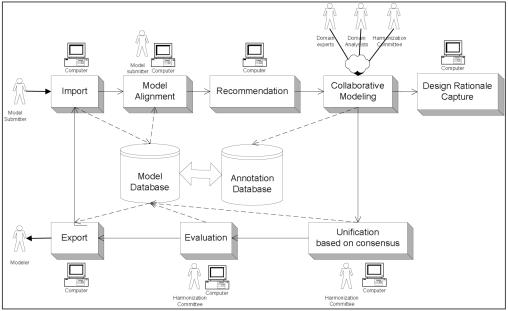Semantic interoperability problems occur when shared vocabularies are used for inconsistent meanings in varied contexts among distributed and heterogeneous healthcare information systems. Methods such as XML only work at the syntax level and do not deal with semantics. We are missing the tools that support consensus semantics modeling across multidisciplinary healthcare communities. Here we briefly define what collaborative semantic harmonization is and describe an early design to achieve it.
2. Motivation
The plethora of clinical data domain analysis models often cause overlaps and conflicts and severely interfere with global healthcare information sharing. For example, in cancer clinical trial research, various communities such as FDA, NCI, HL7, CDISC, and phRMA have developed various clinical trials domain analysis models and created myriad standards; however, clinical trial management systems based on these models could not easily interoperate. During standardizing clinical trial research, modeling technology is not a problem; what remains challenging is the harmonization of semantics modeling practices across different stakeholders and communities. As Braman pointed out, “harmonization of systems is the third stage of the information society; the information space did not emerge full-blown; after we get enough digital information, a subsequent task is information harmonization.” There is an urgent need for a well-coordinated, efficient, and collaborative approach to model coherent semantics based on group consensus across distributed healthcare data sources. We call it collaborative semantic harmonization.
3. A Conceptual Design
Related work for collaborative semantic harmonization includes harmonization of international standards and laws. This research differs from traditional information integration or model mapping/alignment research in that this work strongly emphasizes consensus content and human group work, while the latter is usually an automatic approach with minimum user involvement. We identify three key design principles: (1) reuse: to increase the access to existing semantics resources and to make them reusable for new semantic model development efforts; (2) collaboration: to support group decision making and to seek group consensus of shared semantics; (3) harmonization as modeling: to resolve semantic differences through annotations and to represent shared semantics in formal models during harmonization.
A collaborative semantic harmonization system is an open environment designed for unifying similar knowledge models based on the consensus of collaborative domain experts to achieve better knowledge reuse and semantic interoperability. This following figure illustrates our current system design.



